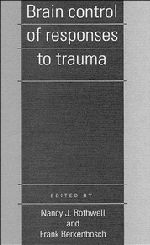Book contents
- Frontmatter
- Contents
- Contributors
- 1 Introduction
- 2 Responses to injury
- 3 Experimental approaches to the central nervous system control of responses to trauma
- 4 Neurohormonal control of cytokines during injury
- 5 Brain regions involved in modulation of immune responses
- 6 Psychological and neurobiological consequences of trauma
- 7 Central nervous system control of sickness behavior
- 8 Psychological and behavioural aspects of pain
- 9 Central control of cardiovascular responses to injury
- 10 Neuroendocrine responses to physical trauma
- 11 Central control of metabolic and thermoregulatory responses to injury
- 12 Central control of pain
- 13 The final word …
- Index
12 - Central control of pain
Published online by Cambridge University Press: 05 August 2016
- Frontmatter
- Contents
- Contributors
- 1 Introduction
- 2 Responses to injury
- 3 Experimental approaches to the central nervous system control of responses to trauma
- 4 Neurohormonal control of cytokines during injury
- 5 Brain regions involved in modulation of immune responses
- 6 Psychological and neurobiological consequences of trauma
- 7 Central nervous system control of sickness behavior
- 8 Psychological and behavioural aspects of pain
- 9 Central control of cardiovascular responses to injury
- 10 Neuroendocrine responses to physical trauma
- 11 Central control of metabolic and thermoregulatory responses to injury
- 12 Central control of pain
- 13 The final word …
- Index
Summary
Injury and pain
In sensory physiology there is a general rule that perceived sensation is proportional to the intensity of the stimulus applied. This is true for the perception of pain as it is measured in controlled studies on human volunteers, in which increasing the strength of a stimulus towards intensities that threaten tissue damage gives rise to pain of escalating intensity (see Meyer & Campbell, 1981). In the field, however, the experience of pain is rather more difficult to predict. There are many recorded instances of quite severe injuries sustained in moments of emotional stress, which were initially unaccompanied by pain, and others, of pathological states, where acute pain was felt in the absence of noxious stimuli (see Melzack & Wall, 1988). These are extreme examples of how injury and pain may become dissociated, but they serve to illustrate that the transmission of impulses related to pain in the central nervous system (CNS) is subject to powerful modulatory influences.
The function of pain is primarily one of protection. Stimuli that cause pain activate an array of responses, including reflex withdrawal and the 'fight or flight’ reaction, that have evolved to minimize tissue damage. If these strategies are not fully successful and an injury is sustained, pain acts as an urgent reminder that damage has occurred and encourages behaviours that protect the site of the lesion. In order to best serve its protective role, the nociceptive system must be adaptable to the context within which the pain message is to be generated. This chapter explores our current understanding of the nature of the central mechanisms which influence nociceptive transmission, concentrating on how traumatic stimuli themselves may activate these mechanisms. Before discussing the modulation of nociception, it is first necessary to introduce the basic elements of the nociceptive system and to look at ways in which pain may be measured.
The nociceptive system
Stimuli that threaten or actually cause tissue damage are detected by nociceptors located around the external surfaces of the body, within deep tissues such as muscle, and in the walls of hollow organs. Their response characteristics vary according to their location. Nociceptors in the skin may respond to mechanical distortion, temperatures above 45 °C, or irritant chemicals (for a review, see Perl, 1984), whereas those in the walls of viscera respond most readily to distension or smooth-muscle spasm (for a review, see Gebhart & Ness, 1991), i.e.
- Type
- Chapter
- Information
- Brain Control of Responses to Trauma , pp. 295 - 331Publisher: Cambridge University PressPrint publication year: 1994
- 3
- Cited by

